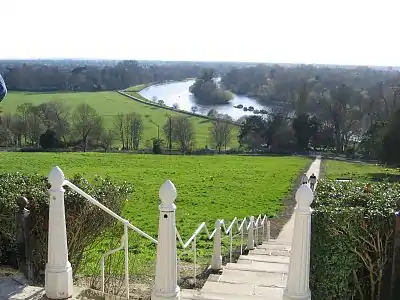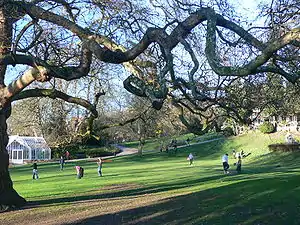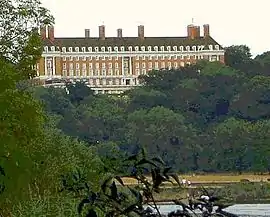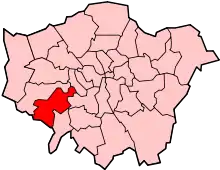Richmond Hill, London
Richmond Hill in Richmond, London is a hill that rises gently on its northern side from the ancient Thames meadowlands around the site of Richmond Palace up to and slightly beyond the Richmond Gate entrance to Richmond Park, the former royal deer park 'emparked' or enclosed by Charles I. The descent southwestwards from this point back down to the upstream meadows is noticeably steeper, although the down gradient is less marked on its southerly and easterly progress through the park itself. Richmond Hill is also the name of the road (now classed as the B321) that runs from Richmond town centre to the top of the hill, and is one-way up the hill along its northern part.

Richmond Hill, as a name, is an unintentional pleonasm where “-mond” (mound) and hill means practically the same thing. The origin as a description of a place in France (through an intermediary of a person from the place then Richmond, North Yorkshire) has lost its use as a description to become a general place name. It just so happens that another hill ended up adopting its name.
This renowned hill offers the only view in England to be protected by an Act of Parliament—the Richmond, Ham and Petersham Open Spaces Act passed in 1902—to protect the land on and below Richmond Hill and thus preserve the fine foreground views to the west and south. Immortalised in paintings by Sir Joshua Reynolds and J. M. W. Turner,[1][2] it was described by Sir Walter Scott as "an unrivalled landscape". It was this view that inspired the name of Richmond, Virginia, after colonial city founder William Byrd II noticed a curve in the James River that remarkably resembled this meander of Thames.
The scenic panorama may be viewed from Terrace Walk, laid out near the top of the hill in the 18th century. This promenade surmounts the Terrace Gardens and both are Grade II* listed in Historic England's Register of Parks and Gardens of Special Historic Interest in England.


.jpg.webp)
As the town of Richmond developed from its founding in the early 16th century, after Henry VII had established Richmond Palace, the attributes of the hill naturally attracted desirable residential and commercial development – with the result that many substantial properties came and went on the hill over the centuries, some of them with famous or notable persons as owners or occupiers. That situation is still in vogue today.
The original homes on Richmond Hill were built in what is now The Vineyard, including Clarence House,[3] Halford House,[4] Michel's Almshouses[5] and Vineyard House.
References
- Warde-Aldam, Digby (15 September 2013). "Revolutionary Richmond?". Apollo. Retrieved 4 December 2014.
- "Turner & Constable & their Contemporaries: Sketching from Nature". Forthcoming events and exhibitions at the Laing. Laing Art Gallery. 2014. Archived from the original on 3 April 2014. Retrieved 4 December 2014.
- Orr, Stephen. "Clarence House". The Vineyard, Richmond. Retrieved 7 May 2013.
- Orr, Stephen. "Halford House". The Vineyard, Richmond. Retrieved 7 May 2013.
- Orr, Stephen. "Michel's Almshouses". The Vineyard, Richmond. Retrieved 7 May 2013.
Further reading
- Richmond Local History Society (2019). The Streets of Richmond and Kew (3rd edition), ISBN 978-1912-314010.
